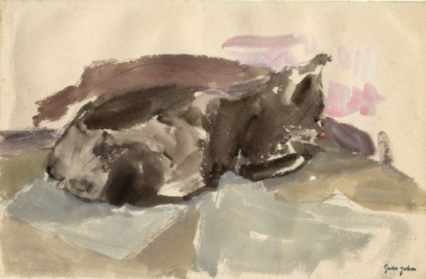Francesca Rhydderch visited the exhibition of Gwen John at the Martin Tinney Gallery in Cardiff, a collection of the artist’s oils and sketches collated by the gallery owner over decades and brought together as part of the 30th anniversary celebrations of the venue.
Gwen John has long since been saved from obscurity by gallerists and scholars, not least by her biographer Sue Roe, and this show at the Martin Tinney Gallery brings together a wonderful range of her paintings and drawings in pencil, gouache, crayon, charcoal and watercolour. John was born in 1876, and died just after the outbreak of war in 1939. Her work can be seen to overlap with broader developments in the visual arts at the time, including a move from naturalism to abstraction. According to Roe, John was a woman who ‘drew a lot of women in a lot of rooms’, and there are several paintings and drawings in this style in the exhibition, some of which can surely be classed as preparatory works for later, fully complete paintings, such as the two sketches here of Dorelia McNeill (c.1903).
There’s something deeply satisfying about viewing the portraits and self-portraits of a female painter of the early years of the last century, a period when women’s lives and preoccupations were still so dominated by men. In the case of Gwen John it is especially pleasing because she moved through various different roles in her life – art student at the Slade, artist’s model in Paris, artist’s lover (the sculptor Auguste Rodin was involved with her for around a decade) – into the role that suited her best, that of the dedicated artist painting in the peace and solitude of Meudon, just outside Paris.
What is most noticeable, seeing twenty-four works side by side like this, is John’s ability to work across different media. The exhibition features nuns painted in oils, for example, their bowed heads covered in white coifs, but there are also loosely pencilled groupings of communicants. As John settled into a more rural life, she began to focus more and more on her technical ability, mostly working out how to create the tiniest shifts in tone and colour. Notes in her journal show her planning her compositions before beginning to sketch and paint the images themselves, and Roe highlights John’s exploratory attempts to create shades of green from chrome yellow and black, also her experiments with sienna, cassel earth, burnt umber.
When John died at the age of sixty-three, a large number of her paintings and sketches were uncovered by her nephew Edwin and brother Augustus (himself an artist), and they belatedly began to fully appreciate the output of their supremely talented relative.
People sometimes talk about the ‘strangeness’ that John tried to capture and encapsulate in her art, and while the concept is difficult to define, it at least gestures towards those elements of art that often remain mysterious to artist and viewer alike. Exhibitions of a single artist’s work are utterly precious in this respect, raising the curtain on artistic inspiration and letting us share in its power for ourselves. Gwen John left behind a significant body of work, and it was pure pleasure to see this selection in one of Wales’ leading galleries.
The Gwen John exhibition is on at the Martin Tinney Gallery in Cardiff until July 16th.
The header image is “Sleeping Back Cat” by Gwen John (mixed media).












